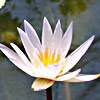The blue water lily is a perennial aquatic plant of which most of the plant body is submerged and only the leaves and flowers float on the water surface. It grows in shallow fresh-water bodies no deeper than 1.5 meters. In the soil underwater, it develops a thick rhizome from which the long leaf petioles extend up to the water surface. The large, 40 cm diameter, circular leaf blades with a notch at the base, float on the surface. They are leathery and shiny and serve as perches for toads, frogs, and birds. The leaves disappear in winter and the plants flourish again in the spring, with a new flash of leaves.
The large flowers, ca. 10 cm diameter, can be seen from March to September. At the base of the flower, there are four light-green lanceolate sepals, which are longer than the petals. There are some 20-30 light-blue or white pointed petals arranged in several whorls. A gradual change of shape can be seen from the petals to stamens with an intermediate whorl of unfertile stamens, called staminodes. The flowers are bisexual and have a pistil at the center. They open in the morning and close in the late afternoon. Pollination is by beetles.
The spongy fruits are oval about 4 cm long. The fruits can be ground to flour which has been used for baking. The other plant parts are edible as well. The rhizomes contain tannins and gallic acid and were used for the production of psychoactive drugs, which are illegal in several countries.
Its scientific name is after the nymphs which were Greek Mythology spirits of nature imagined as beautiful maidens inhabiting rivers, woods, or other locations. Archaeological exhibits depict its use in religious rituals in ancient Egypt, and similar uses of related species also in the Maya culture in Central America, and Ancient cultures in India.
Its origin is East Africa and Israel is the Northernmost extent of its distribution. As a result of the loss of aquatic habitats in the country on one hand, and damage by the invasive aquatic rodent Nutria on the other, this species is on the verge of extinction in Israel.
Written by Mike Livne






